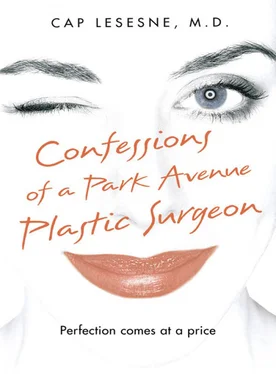I also believe that there are strategies, in contrast to those of some of my colleagues, that allow me to achieve more natural results. “Where did Greta Van Susteren go?” patients of mine wondered, along with many others, even after the Fox TV anchor admitted to eyelid procedures (she never confessed to more). “Please don’t make my mouth like Melanie Griffith’s,” patients will demand before I inject their lips with Restylane. Or they might ask me, “What happened to Leslie Ash?” (Angelina Jolie’s name is also invoked, but in her case it appears the lips are her own.) The obviously plasticized look is not the usual goal of my patients; subtlety makes them happy. “Natural” is my guiding aesthetic principle. For facial surgery, my goal is twofold: to make my patient look phenomenal, and to make no one suspect why she looks phenomenal. I want her to be able to pull her hair back without any visible scars. A patient from Texas once paid me one of my favorite compliments: “You made me look younger, intellectual, and sexy.”
On the other hand, I find it comical that so many women come in for breast augmentation thinking their husband or boyfriend won’t know. They’re shocked – “Can you believe it?” they ask me – when their partner deduces it in three nanoseconds.
Many surgeons plan their procedures as a matter of routine, without accommodating the patient’s physiognomy or individual traits. My profession is degraded, I feel, by practitioners who perform the same style of operation regardless of the subject’s nose, face, or body habitus. But there are overbooked surgeons in Los Angeles, Miami, and elsewhere who insert the nearly identical pair of oversize breast implants on a vast cross section of their patients (including office staff, wives, and even daughters), so that every woman who leaves the office sports two half-grapefruits. The result is so artificial that many of us can’t help but wonder, “What was the surgeon thinking? What was the patient thinking?” Even though I spend all my day with women, and many of my closest friends are women, there are some questions I can’t answer.
Then again, other questions that people think they have answered, I would challenge. For instance, I believe it’s a myth that Michael Jackson is a plastic surgery victim. People assume that everyone believes he’s a victim, including Mr. Jackson himself. That he must hate his face (and himself) or else why would he have gone back for more and more and more.… You know what I think? That he likes his surgery. A lot. If he’d been unhappy with what was happening to his face and wanted to reverse it, he could have, to an extent. But he never did. He had an idea of what he wanted, and he’s been following that road since. We may think it looks bad. I don’t believe he thinks so.
Here’s another myth: People who have plastic surgery have complicated feelings about it. No, they don’t – not usually. Those who haven’t had plastic surgery hyperanalyze the motivations of those who have. For most of my patients, it’s a simple decision. They want to fix something that bothers them. Period. No Freudian analysis, no overthinking. Almost every magazine article critical of plastic surgery is usually written by someone who’s never felt that urge.
Another reason I write this book is because I’ve thought deeply about the face, skin, aging, and plastic surgery, and I want to share what I know to be true and false with my patients, with those interested in plastic surgery, and with other physicians. Better education about my profession is good for me, my colleagues, and, most important, future patients. Without knowledge, how does a first-time consult know what to look for in a plastic surgeon? Or what to ask the surgeon? I’ll include some guidelines.
I love being a plastic surgeon. I love its intellectual demand and technical artistry. Most of all, I love that I make people happy. I’m with my patients every step of the process, for every suture. Many Park Avenue plastic surgeons don’t see their patients postoperatively: The resident or post-op nurse treats them. Not me. My mentor at Duke Medical School, Dr. David Sabiston, impressed upon me that they’re my patients from the moment they enter the OR until the incisions have matured, sometimes more than a year later. As the captain of the ship, I am responsible for anything that happens to them, plastic-surgery-related, while in my care. This simple lesson in accountability has made me a better surgeon because I see changes in healing and other nuances that, were I not doing my own follow-up, I might not notice or fully understand. (Two examples: With a smoker who’s had a tummy tuck, I can tell sooner, by the shade of blue on her skin, whether she’ll have problems with her wound healing. With a face-lift patient, I can tell whether scars need to be massaged.) And because my patients always see me, not an unknown, the relationship is more gratifying.
Which brings me to the last reason I write this book: to share what it’s like to live the life of a plastic surgeon. We’ve all seen slices of it (pun intended) on hit TV series such as Nip/Tuck, a fictional drama, and Extreme Makeover and The Swan. But these programs, both fictional and “reality,” offer stylized, often sensationalized, depictions of that life. Among books on the subject, none of those written by plastic surgeons talk in detail about the life we live, its daily rigors and quirks. And books about plastic surgery by journalists, while occasionally well researched, don’t come close to capturing the essence of our sense of responsibility to each patient, the numerous details we must consider with each procedure, why we make the decisions we do, and why we make the mistakes we sometimes do. I’ll provide an insider’s view that outsiders can’t, because they don’t live it.
For example, how about this paradox to our life: Can one succeed in a profession suffused with one kind of intimacy without also sacrificing – or at least challenging – intimacy in one’s personal life? I’m usually scrubbed for surgery before the sun rises, so I have to be in bed early. The society cocktail parties, museum benefits, and charity functions to which I’m often invited – and where I regularly see former and future patients – are, for me, restricted functions. I’m expected to be a diplomat, to be cool and calm, always restrained. It’s one glass of wine, tops, and nothing after nine thirty; I’m a doctor. I have to be responsible. I must focus on my surgery.
Even my avocations can be colored by the fact that, like most plastic surgeons, I’m always “on.” When I’m at the Metropolitan Museum of Art or the Frick Museum, I wander the halls looking at spectacular paintings and sculpture, yet I can’t help but analyze them as if they were patients. The young wife in Peter Paul Rubens’ Rubens, His Wife Helena Fourment, and Their Son Peter Paul looks overweight; she could use a neck liposuction. Venus in Titian’s Venus and Adonis is often regaled as the paragon of female perfection, but, to my eye, she’s disproportionate. And whenever I see John Singer Sargent’s magnificent Madame X, which depicts a side view of her large nose with its dorsal hump and flared nostrils, I can’t help but think, What would she look like if I reduced her tip projection and rasped her dorsum?
This out-of-office PSR – Plastic Surgeon’s Radar – is not just operative while I’m strolling the halls of a museum; it’s frequently on during social functions, including when I’m having dinner with a woman. It’s not long before the more daring of my dates will ask me to comment on what she may or may not need – and sometimes they don’t like the reply. One woman, while dancing with me on our second date, challenged me to assess her breasts: “Cap” – my nickname – “what size do you think they are?”
Читать дальше












